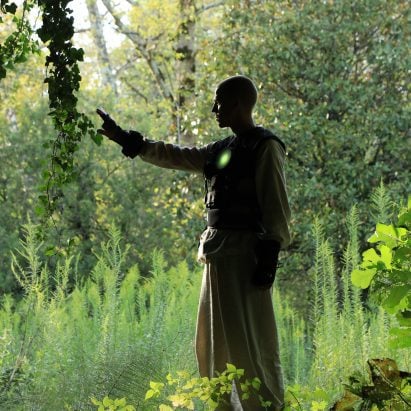Analysis of the iconic telephone box among University of Southampton projects


Dezeen School Shows: a publication dedicated to the history of the UK's currant red telephone box is among the graphic design projects from the University of Southampton.
Also featured is a typeface design exploring the application of fonts to digital formats and a book presenting the development of cystic fibrosis treatment.
University of Southampton
Institution: University of Southampton
School: Winchester School of Art
Course: BA Graphic Communication
Tutor: Jodie Silsby
School statement:
"The BA Graphic Communication course participates in international competitions each year, providing valuable opportunities that can enhance students' career prospects. These competitions are globally recognised within the industry and help our graduates become internationally competitive.
"ISTD (International Society of Typographic Designers) is an international awarding body that engages with universities and institutions to raise the typographic standards and design practice.
"Students are taught on the BA (Hons) Graphic Communication programme to apply a more critical approach to typography, composition and overall control of print. Students compete and submit work that demonstrates their awareness of typography to an advanced and professional level.
"Each year, students are successful in obtaining membership to this society. This year, a combination of eight of our international and national students were awarded with this prestigious accolade resulting in a combination of the highest results commendation, merit and pass.
"All our students who undertake the ISTD assessment are successful go into employment after graduating, these have been in high profile studios, institutes and creative media companies such as Pentagram, Mr President, Femme Press, Phantom, Studio Lowrie, Studio Bergini, De La Rue, Ilovedust, It's Nice That and The Brand Identity."

Broken Link by Jas Jones
"The concept is based on the Channel Tunnel and how it was a significant milestone. This is because it was the first direct link between the UK and Europe, boosting the economy and general access.
"This milestone took 100 years of failed planning and attempts before the two countries, agreed on construction. Twenty years from its completion, Britain left the European Union after a 52 per cent win in a referendum.
"This started a process known as Brexit, which wasn't such a positive milestone, restricting the UK's connection to Europe and the European Union.
"This vote changed our trade deals, jobs, economy, travel rules and foreign residencies. The book aims to educate and emphasise the efforts that made an incredible connection between the UK and Europe.
"The tunnel provided freedom of movement and a connection to other cultures giving the opportunity for everyone to learn and develop."
Student: Jas Jones
Course: BA Graphic Communication
Tutor: Jodie Silsby
Email: jasminesj[at]icloud.com

1969: When Attitudes Become Form by Duye Li
"'Live in Your Head: When Attitudes Become Form' was an exhibition held at the Kunsthalle Bern in Switzerland in 1969, curated by Swiss curator Harald Szeemann.
"Widely regarded as a groundbreaking moment in the history of conceptual art, the show was described by The New York Times as 'arguably the most famous exhibition of new art of the postwar era'.
"The exhibition redefined the relationship between curator and artist, establishing a model of collaboration rather than hierarchy. It featured 127 works by 69 artists from Western Europe and the United States.
"Many of the works were constructed on-site and were process-oriented, emphasising ideas and actions over finished objects. Participating artists included Eva Hesse, Gary Kuehn, Lawrence Weiner, Alighiero Boetti, Joseph Beuys, Bruce Nauman, Hanne Darboven, Mario Merz and Hans Haacke, among others.
"The exhibition also marked a turning point in Szeemann's career, allowing him to move beyond institutional constraints and establish himself as one of the first truly independent curators.
"Taking this exhibition as a milestone, this publication responds to the ISTD brief, 'Milestone' by highlighting its significant influence on contemporary art and its enduring legacy in the history of exhibition-making.
"In addition to examining the exhibition itself, it revisits key events of 1969, providing broader historical context to help readers better understand the cultural and political climate in which the exhibition emerged.
"This framing enables a more comprehensive understanding of the intentions behind the works of the artists and the curator, as well as the conceptual art movement as a whole."
Student: Duye Li
Course: BA Graphic Communication
Tutors: Jodie Silsby and Ian Jackson
Email: leah711711[at]gmail.com

OCD: Celebrating the Cycle by Sophie Child
"The aetiology of obsessive-compulsive disorder is still an enigma to scientists due to the complex range of neural, genetic and cognitive factors involved.
"One branch of research proposes an imbalance in the neural pathways within the brain's cortico-striato-thalamo-cortical (CSTC) circuit, which results in a feedback loop that drives a vicious cycle of obsessions and anxiety-provoking thoughts or images.
"Compulsions manifest as a means of protection from these obsessions – whether through internal dialogues or physical actions – and only increase in severity if resisted.
"They can take the form of: ruminating through a set of hypotheses to assess your moral compass, washing your hands repeatedly to avoid contamination from foreign objects or checking electronic devices across the house before leaving, to ensure they do not set alight.
"My publication will not only illustrate how the condition functions as a cyclical, internal communication system through personal accounts and individual experiences, but celebrate the achievements of those who, despite their OCD, have shaped industries and shifted social stigmas.
"Through these intimate narratives, it will offer comfort and educate those with and without OCD, who grew up in the late 20th century – a time when the mental health disorder was often ridiculed."
Student: Sophie Child
Course: BA Graphic Communication
Tutors: Ian Jackson and Jodie Silsby
Email: sophie.child[at]virginmedia.com

London Calling by Yanqing Wang
"This book design project aims to document the history of the telephone kiosk from its inception to its decline. Designed by Sir Giles Gilbert Scott, the red telephone box is a symbol of Britain.
"However, with the popularity of mobile phones, phone booths are gradually disappearing from our lives and have become an unfamiliar presence. This publication focuses on the glory and decline of this historic design.
"The publication is divided into two parts – 'celebration' and 'decline'. The first half of the publication looks back over 80 years of the development of the telephone box, from K1 to KX100 and explores the public perception and use of public telephones in the UK.
"The second half details how the telephone kiosk has gradually gone into decline. The publication draws on a wide variety of textual sources, including books by authors, newspaper articles, news reports, public comment and my first-hand research photography and maps.
"The overall design style draws on British modernism – now an infamous movement, which coincides with the glory-to-decline of the telephone booth.
"The publication employs a dynamic grid system, which is moderately breached in the second half of the publication as the content shifts to a narrative of decline and the text layout becomes more free-flowing.
"A serif typeface was chosen for the headline, inspired by the word 'telephone' on a telephone box, and combined with a body text in the famous British Gill Sans typeface.
"The size of the pages is also inspired by the telephone booth, and the width of the pages is slightly wider than the original proportions, to improve the reading experience."
Student: Yanqing Wang
Course: BA Graphic Communication
Tutors: Jodie Silsby and Ian Jackson
Email: wyqwangyq[at]outlook.com

Noughts and Crosses by Sophie Struthers
"Malorie Blackman's Noughts and Crosses, published in 2001, is an award-winning young adult novel following the love story of Callum, a nought (white) and Sephy, a cross (black).
"The characters navigate a world divided by race, reflecting the historical context of the civil rights movement.
"Blackman's fiction text is her response to directly tackle the topic of racism, informed from her own experience growing up as a Black British woman and the anger she felt regarding Stephen Lawrence's murder and the Metropolitan Police's mishandling of its enquiry.
"To explore these themes of racism, inequality and segregation, Blackman creates an alternate history, where Black people are the elite upper-class, and white people are the mistreated second-class citizens.
"Therefore, Noughts and Crosses intends to instigate conversations about equality for people of colour in a way that makes it more understandable and comfortable to white people.
"The novel is also written in a style and tone to make the topic more accessible for younger audiences."
Student: Sophie Struthers
Course: BA Communication Design
Tutors: Jodie Silsby and Ian Jackson
Email: sophie.1211[at]outlook.com

Someone in my Head by Jacob Johnson
"Someone in My Head is a publication created in response to the milestone brief, examining the influence of Pink Floyd's 'The Dark Side of the Moon' on British society.
"The album broke societal and musical taboos through its open discussion of themes such as madness, mental health and existentialism.
"This publication aims to translate those struggles into rhythmic storytelling, focusing on the albums themes that resonate with the everyday citizen, how these struggles can turn one mad and aims to assist and support those who feel the same.
"The publication begins contextualising the societal struggles and anxieties leading up to 1973, and how this album felt necessary to Pink Floyd. The band witnessed the eventual mental decline of their dear friend and ex-band member Syd Barrett, reforming their perspective of mental health, isolation and the psychedelic drugs that likely caused it.
"Someone in My Head is by no means a celebration of madness, but a introspective analysis of the album's ability to resonate with a society grappling with its own struggles. The publication continues with chaotic imagery and further information, articles and perspectives on the impact of The Dark Side of the Moon."
Student: Jacob Johnson
Course: BA Communication Design
Tutors: Jodie Silsby and Ian Jackson
Email: jacobjohnsonarts[at]gmail.com

Kaftrio by Katy Davies
"Kaftrio is a response to the ISTD brief 'milestones'. This publication focuses on factors that contributed to the permanent access of the cystic fibrosis treatment, Kaftrio, on the NHS in 2024. It highlights the several medical breakthroughs that made Kaftrio possible.
"However, instead of viewing Kaftrio from its medical evolution, this publication also presents the developments in politics, economics and society that contributed.
"It took over four years to get Kaftrio permanently approved on the NHS. By viewing Kaftrio's journey from this holistic perspective we can see the reality of avoidable factors, political, economic and social, prolonging access to drugs.
"We can learn from Kaftrio's journey to learn what can be done, where to improve, what we as individuals can do to shorten the timeline for future treatments. The faster the process, the more lives are saved."
Student: Katy Davies
Course: BA Graphic Communication
Tutor: Jodie Silsby
Email: katy.davies2003[at]gmail.com

Unica by Donna Ji
"The design concept of this type specimen revolves around digital space, reflecting the journey of Neue Haas Unica from its origins, based on three other typefaces (Akzidenz-Grotesk, Helvetica and Univers), to its decline due to technological advancements and copyright challenges.
"However, after being rediscovered and revived by Monotype, the font has been perfectly adapted to modern digital devices. The specimen follows this timeline, highlighting the font's revival and showcasing its distinctive features, especially its clarity and visibility at small sizes.
"By incorporating code-inspired typographic design elements, like binary code, the design bridges the gap between its historical context and contemporary relevance.
"This type specimen emphasises the evolution of the typeface from being forgotten to being rediscovered, illustrating its adaptability and significance in the digital age."
Student: Donna Ji
Course: BA Graphic Communication
Tutors: Jodie Silsby and Ian Jackson
Email: donnna1114[at]gmail.com
Partnership content
This school show is a partnership between Dezeen and the University of Southampton. Find out more about Dezeen partnership content here.
The post Analysis of the iconic telephone box among University of Southampton projects appeared first on Dezeen.





_003.JPG)

.jpg)











































